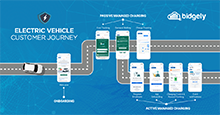Spence went on to discuss Avangrid’s next managed charging program roll out in New York state.
“We are soon going to be launching a very similar program in New York, except that we’re adding managed charging to the demand response,” he described. “We’re giving customers the option to either respond to signals on a basic level where they might earn if they decide not to participate on a given day. Or, they can opt-in to a more active managed charging program where people are earning more, but are also expected to allow us more flexibility to control their vehicle to a greater degree.”
Looking down the road past the program evaluation phase, Spence says Avangrid is simultaneously planning for the technology available today as well as what’s on the horizon – including how energy providers and consumers will increasingly work together.
“In terms of the broader strategy, we are thinking about the managed charging and the demand response programs that we can implement now. But we’re also cognizant of the fact that there’s vehicle-to-grid technology coming soon,” he said. “The vehicle-to-grid stuff is excellent. It’s an opportunity to evolve the utility customer relationship to a point where, rather than us selling kilowatt hours exclusively, consumers will also be able to sell them back to us. And we’ll have a nice little dynamic there.”
Spence said he is also looking forward to the broader adoption of telematics and its potential to inform grid planning.
“Telematics basically gives us the use of the onboard EV computer. Some models have a stronger capability where you don’t only see the data, you can also turn the charger on and off, and understand where people are charging and how much they’re charging. We’re using telematics not only for direct load control — where we turn off charging for a demand response event or throttle it slightly — but also to understand charging behavior outside the home charger. Most charging happens at home, but there is 20 percent-ish that happens elsewhere. And that is huge. Public charging generally occurs in constrained urban areas, which are the same places where grid upgrades are most expensive and the most disruptive to people’s lives. We want to avoid digging up concrete as much as possible. If we’re putting level-two, or even DC fast charging out in these contexts, we want to know who’s using it, when they’re using it, and how they’re using it. And telematics enables that.”
Spence pointed out that, because Avangrid is a subsidiary of the global Iberdrola group, they have a unique advantage in that they can learn from the EV experience of their European counterparts.
“We do get quite a bit of support,” Spence acknowledged. “We know that folks in the various European countries are there to answer questions and we can count on their assistance with EV messaging and knowing how to position EV programs in a way that speaks to people both in a value sense, but also in empathetic sense, to improve engagement.”
When asked what it takes to get EV strategy right, Spence replied that, “There are all sorts of ways we could measure success. Fundamentally, we have to get the load integrated and timed properly. But beyond that, we have to really work through that change in the utility-customer relationship. We have to move from an approach where we just send a bill to one where we have a little bit of back and forth with our customers. If we’re going to integrate the load that we are expecting, we have to have participation and buy-in from the customer, and that requires trust, ease of participation, meaningful insights, and lifestyle and financial help as well. If we’re, for example, going to get somebody to, on a regular basis, let us turn off their EV charging for a couple of hours several times a month, they need to know that we are going to be providing them with value — both monetary and lifestyle.”
If you’d like to hear more from Avangrid about its data-driven EV strategy, watch the full Engage+ episode on demand and sign up now to receive updates about future episodes.














